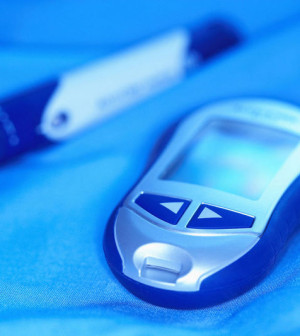- Skip Storing This Everyday Product in the Fridge Door
- Green Tea + B3 Pairing May Boost Brain Health
- Navigating Your Midlife Crisis: Embracing New Possibilities
- City Raccoons Showing Signs of Domestication
- Mapping the Exposome: Science Broadens Focus to Environmental Disease Triggers
- One Week Less on Social Media Linked to Better Mental Health
- Your Brain Changes in Stages as You Age, Study Finds
- Some Suicide Victims Show No Typical Warning Signs, Study Finds
- ByHeart Formula Faces Lawsuits After Babies Sickened With Botulism
- Switch to Vegan Diet Could Cut Your Greenhouse Gas Emissions in Half
Mouse Study Suggests Antibiotics in Kids Might Help Spur Type 1 Diabetes

Repeated treatments with antibiotics were linked to the development of type 1 diabetes in mice, a new study finds.
Researchers gave the mice antibiotic doses equivalent to what kids receive to treat something like an ear infection.
After three antibiotic treatments, the researchers saw an “accelerated and enhanced rate of type 1 diabetes in the mice,” said Dr. Martin Blaser, a professor of translational medicine and microbiology at NYU Langone Medical Center in New York City.
Blaser explained that antibiotics led to a change in the microbiome in the gut — or intestinal bacteria. Those changes resulted in other changes, including alterations in immune system cells called T-cells. That, in turn, led to increased inflammation in the insulin-producing islet cells of the pancreas, he said.
So, do all of these changes occur in the same way in humans? It’s too soon to know for sure, though Blaser said other research suggests that kids with autoimmune diseases, such as type 1 diabetes, have an altered microbiome.
Jessica Dunne, director of discovery research for JDRF, formerly called the Juvenile Diabetes Research Foundation, said these changes in the microbiota may play some role in type 1 diabetes, but it’s not yet clear what that role is.
“We still don’t know how or why type 1 diabetes develops. But there’s likely no one smoking gun that we can point to as the cause of type 1 diabetes,” Dunne said.
Both Blaser and Dunne said these findings shouldn’t cause parents to shun antibiotics altogether. Blaser said to rely on your child’s doctor to let you know when antibiotics are necessary and when they are optional.
“We used to think antibiotics were safe, with no side effects. Now we know, everything has some consequences,” said Dunne.
“But still, there is a time and a place for antibiotics,” she added.
Type 1 diabetes is an autoimmune disease that develops when the body mistakenly attacks the insulin-producing cells in the body, according to JDRF. This leaves someone with type 1 diabetes without enough insulin to properly use the carbohydrates in foods as fuel.
Although the exact reasons why the disease occurs remain elusive, researchers do know the disease has genetic and environmental factors.
Since World War II, type 1 diabetes has doubled every 20 to 25 years. Increases occurring that quickly are happening too fast to be caused by genetic changes, Blaser said.
So, he looked for other factors that had also increased dramatically after World War II. One such factor was the use of antibiotics, he said.
“Antibiotics are being used so much. On average, by age 10, a child will have had 10 courses of antibiotics,” Blaser said.
The current study looked at the effects of antibiotics on non-obese mice that were susceptible to type 1 diabetes. Dunne said these mice are the best animal model researchers have for type 1 diabetes.
Researchers used very young mice — Blaser said they’d be similar in age to a 6- month to 1-year old child.
The mice were given pulsed antibiotic therapy (three doses at different time periods); a continuous but very low dose of antibiotics or no antibiotics.
Mice exposed to the pulsed therapy were twice as likely to develop type 1 diabetes compared to mice that got no antibiotics, the study found.
The researchers also transferred some of the changed gut microbiota from the antibiotic-exposed mice to two other groups of mice. This increased the risk of type 1 diabetes in one group, but not the other. The researchers said more study is needed to understand why.
Blaser plans to continue his research. The next step is more mouse studies, and eventually following families with a high risk for type 1, he said.
The hope is to come up with a way to prevent or treat the disease at some point in the future.
In the meantime, Dunne said it’s a good idea to be “cautious about what we’re giving to ourselves and our children. For example, antibiotics won’t help a viral infection. We need to be smart about when we use antibiotics.”
The study findings were published in the Aug. 22 issue of Nature Microbiology.
More information
Learn more about type 1 diabetes from JDRF.
Source: HealthDay
Copyright © 2025 HealthDay. All rights reserved.










